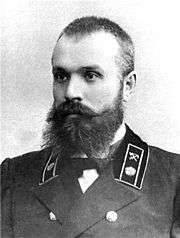Evgeny Paton
| Evgeny Oskarovich Paton Евгений Оскарович Патон | |
|---|---|
|
Evgeny O. Paton — professor at Kiev Polytechnic Institute, 1910's | |
| Born |
March 5, 1870 Nice, France |
| Died |
July 12, 1953 (aged 83) Kiev, Ukrainian SSR |
| Fields | welding |
| Institutions | E. O. Paton Electric Welding Institute, International Association of Science Academies, National Academy of Sciences of Ukraine |
| Alma mater |
Dresden Technical University (1894) Institute of Engineer Corp of Transportation (1896) |
| Known for | Vice-President of the Academy of Sciences of the Ukrainian SSR (1945–52) |
| Notable awards |
|
| Spouse | Natalie Viktorovna Budde |
| Children | Volodymyr, Borys |
|
Signature | |
Professor Evgeny Oscarovich Paton (Russian: Евгений Оскарович Патон, Yevgeni Oskarovich Paton 1870–1953) was a Ukrainian and Soviet engineer who established the E. O. Paton Electric Welding Institute in Kiev. Paton was a people's deputy of the Supreme Soviet of the Soviet Union (1946–1953). He was the father of Borys Paton.
Early career
Born in 1870 in Nice, France, he studied at the Dresden Technical University (graduated in 1894), and at the Petersburg Institute of Railway Roads (graduated in 1896). He designed the structure of the train station in Dresden, and was a lecturer at the Moscow Engineering College of Railway Roads (1889–1904). Paton was a Professor at Kiev Polytechnic Institute and the Chairman of the Bridge Department from 1904 to 1938. In 1929 he organized a welding laboratory and the Electric Welding Committee. In 1934 Paton founded the Electric Welding Institute of the Academy of Sciences of Ukrainian SSR in Kiev. From 1945–1952 he was a Vice-President of the Academy of Sciences of Ukrainian SSR.
Welding research
Paton was a pioneer researcher of joining and welding technology. In order to make welding a reliable technological process, it was necessary to conduct comprehensive research regarding the mechanics of welded structures, the metallurgical processes involved, and the physics of the arc, as well as to develop welding equipment, tools, and techniques.
Paton created methods used in the design of rational bridge spans, investigated the conditions of their operation, and suggested methods for restoring damaged bridges. He carried out research on the fundamentals of welding, how to calculate the strength of welded structures, and the mechanization of welding processes. He supervised the development of automatic submerged arc welding. During World War II Paton supervised the design and production of equipment and technology for automated welding of special steels for tanks, bombs, and other military hardware.

Paton supervised the wide implementation of welding in industry, including the design and production of assembly-line welding systems. He designed welded bridges and founded a domestic school of metal welding. Paton was awarded almost all of the highest Soviet government and scientific awards and prizes, and received the title of the Hero of Socialist Labour.
External links
- Biography at the E.O. Paton Electric Welding Institute
- Biography at the Kiev Polytechnic Institute (in Ukrainian)
- Biography at the Kiev Polytechnic Institute (in English)
